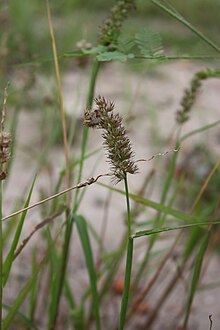
Millets are a group of highly variable small-seeded grasses, widely grown around the world as cereal crops or grains for fodder and human food. Most species generally referred to as millets belong to the tribe Paniceae, but some millets also belong to various other taxa.

Sorghum is a genus of about 25 species of flowering plants in the grass family (Poaceae). Some of these species are grown as cereals for human consumption and some in pastures for animals. One species, Sorghum bicolor, was originally domesticated in Africa and has since spread throughout the globe. Seventeen of the 25 species are native to Australia, with the range of some extending to Africa, Asia, Mesoamerica, and certain islands in the Indian and Pacific Oceans. One species is grown for grain, while many others are used as fodder plants, either cultivated in warm climates worldwide or naturalized in pasture lands. Sorghum is in the subfamily Panicoideae and the tribe Andropogoneae.

Poaceae or Gramineae is a large and nearly ubiquitous family of monocotyledonous flowering plants known as grasses. It includes the cereal grasses, bamboos and the grasses of natural grassland and species cultivated in lawns and pasture. The latter are commonly referred to collectively as grass.

Eragrostis is a large and widespread genus of plants in the grass family, found in many countries on all inhabited continents and many islands.
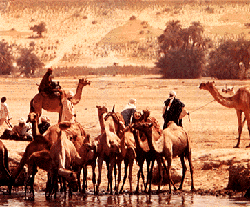
The Sahel is the ecoclimatic and biogeographic realm of transition in Africa between the Sahara to the north and the Sudanian savanna to the south. Having a semi-arid climate, it stretches across the south-central latitudes of Northern Africa between the Atlantic Ocean and the Red Sea.

Pearl millet is the most widely grown type of millet. It has been grown in Africa and the Indian subcontinent since prehistoric times. The center of diversity, and suggested area of domestication, for the crop is in the Sahel zone of West Africa. Recent archaeobotanical research has confirmed the presence of domesticated pearl millet on the Sahel zone of northern Mali between 2500 and 2000 BC.

Pennisetum is a widespread genus of plants in the grass family, native to tropical and warm temperate regions of the world. They are known commonly as fountaingrasses. Pennisetum is considered a synonym of Cenchrus in Kew's Plants of the World Online.
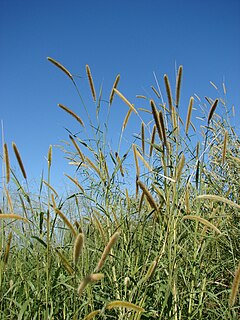
Cenchrus purpureus, synonym Pennisetum purpureum, also known as Napier grass, elephant grass or Uganda grass, is a species of perennial tropical grass native to the African grasslands. It has low water and nutrient requirements, and therefore can make use of otherwise uncultivated lands. Historically, this wild species has been used primarily for grazing, recently, however, it has been used as part of a push–pull agricultural pest management strategy. Napier grasses improve soil fertility, and protect arid land from soil erosion. It is also utilized for firebreaks, windbreaks, in paper pulp production and most recently to produce bio-oil, biogas and charcoal.

Cenchrus is a widespread genus of plants in the grass family. Its species are native to many countries in Asia, Africa, Australia, the Americas, and various oceanic islands.

The Ferlo Desert, also known as the Ferio Desert, is a desert in northern-central Senegal. It is inhabited by the Serer and the Fulani.

Cenchrus agrimonioides is a rare species of grass in the family Poaceae that is endemic to the Hawaiian Islands. Its common names include Kāmanomano and agrimony sandbur. It was formerly distributed throughout the major islands but today it is nearly limited to Oʻahu. Kāmanomano inhabits dry to moist forests and lava plains. It is threatened by competition with non-native plants, predation by ungulates, and wildfire. When this plant became a federally listed endangered species of the United States in 1996 there were fewer than 100 individuals remaining. More recent counts revealed 181 wild individuals on Oʻahu and over 300 more which have been planted to augment the populations. This plant is nearly restricted to the island of Oʻahu, but there are a few individuals known on Maui. A few patches of the grass have been planted on Kahoʻolawe, as well.

Agriculture is the primary economic activity of a majority of Niger's 17 million citizens.

Boscia senegalensis, commonly known as hanza, is a member of the family Capparaceae.

Paspalum scrobiculatum, commonly called Kodo millet or Koda millet, is an annual grain that is grown primarily in Nepal (not to confuse with Kodo and also in India, Philippines, Indonesia, Vietnam, Thailand, and in West Africa from where it originated. It is grown as a minor crop in most of these areas, with the exception of the Deccan plateau in India where it is grown as a major food source. It is a very hardy crop that is drought tolerant and can survive on marginal soils where other crops may not survive, and can supply 450–900 kg of grain per hectare. Kodo millet has large potential to provide nourishing food to subsistence farmers in Africa and elsewhere.

The Senegalese grasshopper is a medium-sized grasshopper species found in the Sahel region of Africa, the Canary Islands, Cape Verde Islands, and West Asia. Although not called a locust in English, this species shows gregarious behaviour and some morphological change on crowding. In many parts of the Sahel, this species may cause greater year-on-year crop damage than better-known locusts, attacking crops such as the pearl millet.
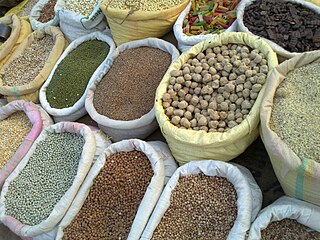
A grain is a small, hard, dry seed – with or without an attached hull or fruit layer – harvested for human or animal consumption. A grain crop is a grain-producing plant. The two main types of commercial grain crops are cereals and legumes.
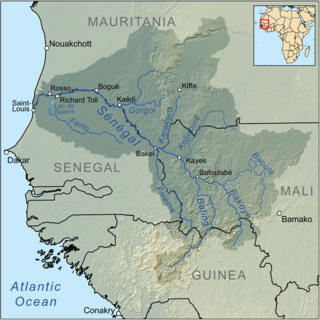
A large-scale, drought-induced famine occurred in Africa's Sahel region and many parts of the neighbouring Sénégal River Area from February to August 2010. It is one of many famines to have hit the region in recent times.
2012 had a very severe drought in the Sahel, the semiarid region of Africa that lies between the Sahara and the savannas. Countries included in this region are Senegal, Mauritania, Mali, Burkina Faso, Niger, Nigeria, Chad, Sudan, and Eritrea. Droughts in the Sahel occur quite often and tend to reduce the already meager water supply and stress the economies of developing countries in that region.
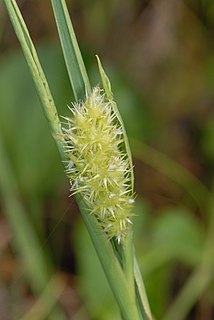
Cenchrus tribuloides, the dune sandbur, is a grass common along the east coast of the mainland United States as well as Hawaii. It is also known as the sanddune sandbur, long-spine sandbur or sand-dune sandspur and is common in sandy, marshy, or loosely forested areas. It differs from C. spinifex in its larger spikelets and smaller number of spikelets per fascicle, and from C. longispinus in its densely pubescent fascicles, fewer bristles, and wider inner bristles.
